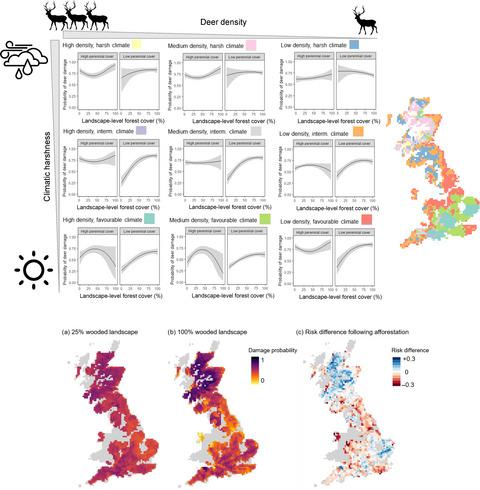当前位置:
X-MOL 学术
›
J. Appl. Ecol.
›
论文详情
Our official English website, www.x-mol.net, welcomes your feedback! (Note: you will need to create a separate account there.)
Forest damage by deer depends on cross‐scale interactions between climate, deer density and landscape structure
Journal of Applied Ecology ( IF 5.7 ) Pub Date : 2020-04-27 , DOI: 10.1111/1365-2664.13622 Rebecca Spake 1 , Chloe Bellamy 2 , Robin Gill 3 , Kevin Watts 3 , Tom Wilson 2 , Ben Ditchburn 2 , Felix Eigenbrod 1
中文翻译:

鹿对森林的破坏取决于气候,鹿密度和景观结构之间的跨尺度相互作用
更新日期:2020-04-27
Journal of Applied Ecology ( IF 5.7 ) Pub Date : 2020-04-27 , DOI: 10.1111/1365-2664.13622 Rebecca Spake 1 , Chloe Bellamy 2 , Robin Gill 3 , Kevin Watts 3 , Tom Wilson 2 , Ben Ditchburn 2 , Felix Eigenbrod 1
Affiliation

|
- Deer (Cervidae) populations are increasing across the temperate zone, threatening forest biodiversity and ecosystem services. However, the fundamental question of what factors make a forest susceptible to deer damage remains unanswered, hampering efforts to mitigate against damage. Previous research has assumed that deer density consistently increases forest damage. However, the effect of deer density is likely to be contingent on a range of other drivers, such as climate and landscape structure. Mitigation measures are expensive, so a sound understanding of these contingencies is required to inform the targeting of appropriate management to forests most at risk of damage.
- Using records of forest damage from Britain's National Forest Inventory, which comprises over 15,000 plots spanning environmental gradients, we applied a multiscale approach to identify the drivers of forest susceptibility to damage by deer.
- Damage likelihood was dependent on drivers operating at multiple spatial scales and their interactions. Broadleaved stands with low tree densities and old trees were consistently found to be at high risk across Britain. The statistical influence of surrounding forest cover within 500 m of a site was modified by regional deer density and climate, in addition to landscape‐level perennial cover. The effect of deer density on damage was therefore not straightforward, but context dependent.
- Synthesis and applications. We predict the likely outcome of afforestation initiatives on the likelihood that a forest site will be damaged by deer, with important implications for management and landscape planning in Britain. The complex interactive effects uncovered are difficult to interpret. We therefore provide an interactive Deer Damage Tool (R Shiny application; https://spake.shinyapps.io/DEERDAMAGETOOL/) for practitioners to visualize how afforestation is likely to influence the probability of deer damage in different forests and regions across Britain.
中文翻译:

鹿对森林的破坏取决于气候,鹿密度和景观结构之间的跨尺度相互作用
- 在温带地区,鹿(鹿科)种群正在增加,威胁着森林生物多样性和生态系统服务。但是,有关什么因素使森林容易遭受鹿类破坏的根本问题仍未得到解答,从而阻碍了减轻破坏的努力。先前的研究假设鹿的密度持续增加对森林的破坏。但是,鹿密度的影响可能取决于其他因素,例如气候和景观结构。缓解措施的成本很高,因此需要对这些意外情况有一个全面的了解,才能将针对适当管理的目标定为最容易遭受破坏的森林。
- 利用英国国家森林资源清单(包括超过15,000个跨越环境梯度的样地)对森林造成的破坏的记录,我们应用了多尺度方法来确定森林易受鹿类破坏的动因。
- 损坏的可能性取决于在多个空间尺度上操作的驾驶员及其相互作用。在英国,始终发现树木密度低和老树的阔叶林高风险。除了景观级别的多年生植物覆盖,还通过区域鹿的密度和气候来修改场地500 m以内的周围森林覆盖的统计影响。因此,鹿的密度对破坏的影响不是直接的,而是取决于上下文的。
- 综合与应用。我们预测了造林计划的可能结果,因为森林地点可能会受到鹿的破坏,这对英国的管理和景观规划具有重要意义。所揭示的复杂的交互作用难以解释。因此,我们为从业者提供了一个交互式的鹿损害工具(R Shiny应用程序; https://spake.shinyapps.io/DEERDAMAGETOOL/),以可视化方式显示植树造林如何影响英国不同森林和地区鹿遭受损害的可能性。


























 京公网安备 11010802027423号
京公网安备 11010802027423号